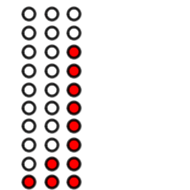

|
- digital
- binary
- electronic
Electronic
"Switches"
As we have already
seen, begining with the ENIAC era computers have been electronic
because the device that represents a digit is not "mechanical"—that
is, it does consist of a moving part, such as a gear—but, rather,
the devices at the heart of electronic computers switch states purely
by means of a change in the flow of electricity through them.
Vacuum Tube
The first such electronic mechanism to represent a digit was the vacuum
tube.
Interestingly, the ENIAC was not binary, but decimal! It used 10 vacuum tubes to represent the digits 0–9.
Let's consider the
number 128 . Here is how ENIAC stored this number (![]() =
the vacuum tube is on):
=
the vacuum tube is on):

The ENIAC required 30 vacuum tubes to store the decimal 128. Ten for the 1, ten for the 2 and ten for the 8. In addition, it had to turn on 11 tubes.
The Atanasoff-Berry (ABC) computer used vacuum tubes, too, but, unlike the ENIAC, the ABC was binary. The number one hundred twenty-eight is written like this in binary: 10000000. Thus, the ABC stored the number this way:
![]()
Because each binary digit can only be 0 or 1, only one on/off switch (here, a vacuum tube) is required for each digit.
Thus, although 10000000 is longer than 128, it can be stored with only 8 switches (instead of 30) and only requires turning on one switch (instead of 11)! This disparity grows even worse with larger numbers.
![]()
![]()
These pages were written by Steven H. VanderLeest and Jeffrey Nyhoff and edited by Nancy Zylstra
Updated 2022-02-02 Chris Wieringa to fix binary errors (thanks Andrew Macdonald)
©2005 Calvin University (formerly Calvin College), All Rights Reserved
If you encounter technical errors, contact computing@calvin.edu.